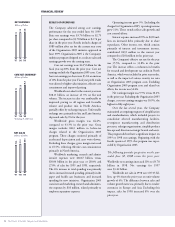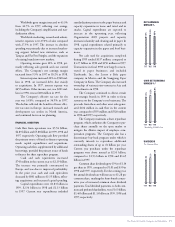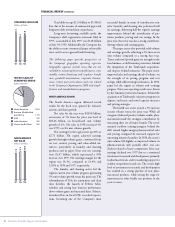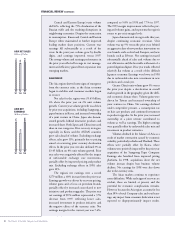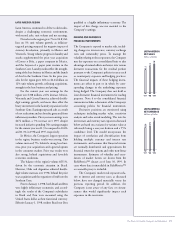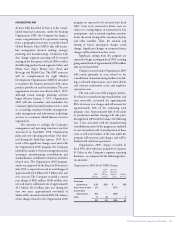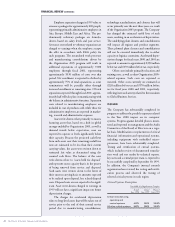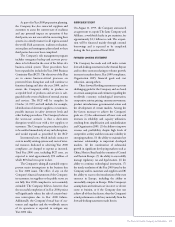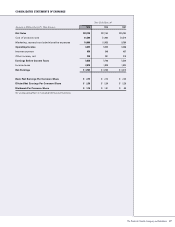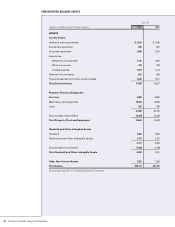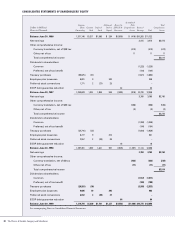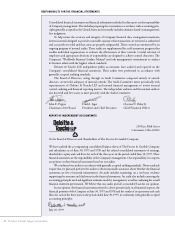Proctor and Gamble 1999 Annual Report Download - page 27
Download and view the complete annual report
Please find page 27 of the 1999 Proctor and Gamble annual report below. You can navigate through the pages in the report by either clicking on the pages listed below, or by using the keyword search tool below to find specific information within the annual report.
The Procter & Gamble Company and Subsidiaries
23
As part of its Year 2000 preparation planning,
the Company has also contacted suppliers and
customers to assess the current state of readiness
and any potential impact on operations if key
third parties are not successful in converting their
systems in a timely manner in all regions around
the world. Risk assessment, readiness evaluation,
action plans and contingency plans related to these
third parties have now been completed.
The Company’s risk management program
includes emergency backup and recovery proce-
dures to be followed in the event of the failure of a
business-critical system. These procedures have
been expanded to include the Year 2000 Business
Continuity Plan (BCP). The objectives of the Plan
are to ensure business-critical processes are
protected from disruption and will continue to
function during and after the year 2000, and to
ensure the Company’s ability to produce an
acceptable level of products and services is safe-
guarded in the event of failures of external systems
and services. The BCP will be complete by
October 31, 1999 and will include, for example,
identification of alternate suppliers or customers,
possible increases in safety inventory levels and
other backup procedures. The Company believes
the worst-case scenario is that a short-term
disruption would occur with a few suppliers or
customers. The Company has procedures in place
to be notified immediately of any such disruption,
and would respond as prescribed by the BCP.
Incremental costs, which include contractor
costs to modify existing systems and costs of inter-
nal resources dedicated to achieving Year 2000
compliance, are charged to expense as incurred.
Total Year 2000 costs, including BCP costs, are
expected to total approximately $90 million, of
which 86% has been spent to date.
The Company is taking all reasonable steps to
prevent major interruptions in the business due
to Year 2000 issues. The effect, if any, on the
Company’s financial statements if the Company,
its customers, its suppliers or the public sector are
not fully Year 2000 compliant is not reasonably
estimable. The Company believes, however, that
the successful completion of its Year 2000 project
will significantly reduce the risk of a major busi-
ness interruption due to Year 2000 failures.
Additionally, the Company’s broad base of cus-
tomers and suppliers and the worldwide nature
of its operations is expected to mitigate any
Year 2000 risks.
SUBSEQUENT EVENT
On August 11, 1999, the Company announced
an agreement to acquire The Iams Company and
Affiliates, a worldwide leader in pet nutrition, for
approximately $2.3 billion in cash. The acquisi-
tion will be financed mainly through external
borrowings and is expected to be completed
during the first quarter of fiscal 2000.
FORWARD-LOOKING STATEMENT
The Company has made and will make certain
forward-looking statements in the Annual Report
and in other contexts relating to volume growth,
increases in market shares, Year 2000 compliance,
Organization 2005, financial goals and cost
reduction, among others.
These forward-looking statements represent
challenging goals for the Company and are based
on certain assumptions and estimates regarding the
worldwide economy, technological innovation,
competitive activity, pricing, currency movements,
product introductions, governmental action and
the development of certain markets. Among the
key factors necessary to achieve the Company’s
goals are: (1) the achievement of lower costs and
increases in reliability and capacity utilization,
resulting from simplification and standardization
and Organization 2005, (2) the ability to improve
revenue and profitability despite high levels of
competitive activity and the economic volatility in
emerging markets, (3) the ability to maintain key
customer relationships in important developed
markets, (4) the continuation of substantial
growth in significant developing markets such as
China, Mexico, Brazil and the countries of Central
and Eastern Europe, (5) the ability to successfully
manage regulatory, tax and legal matters, (6) the
ability to continue technological innovation, (7)
the timely resolution of the Year 2000 issue by the
Company and its customers and suppliers and (8)
the ability to react to the introduction of the euro
currency in Europe, including the ability to
successfully compete in Europe. If the Company’s
assumptions and estimates are incorrect or do not
come to fruition, or if the Company does not
achieve all of these key factors, then the Company’s
actual performance could vary materially from the
forward-looking statements made herein.



